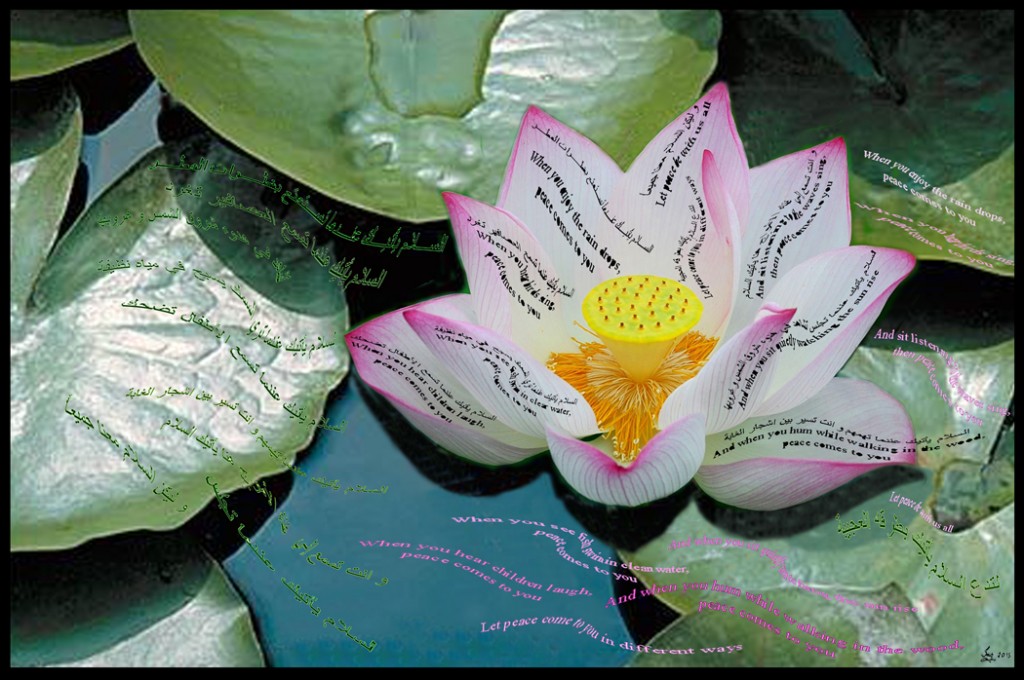 Artwork by Ing-On Vibulbhan-Watts
Artwork by Ing-On Vibulbhan-Watts
Ing’s Peace Poem Translated into Arabic
And Egyptian Art History Part 2
Ing’s Peace Poem “Peace Comes to You”
Translated into Arabic by Nancy Emad on October 14, 2015
The Egyptian language is a northern Afro-Asiatic language closely related to the Berber and Semitic languages.[123] It has the second longest history of any language (after Sumerian), having been written from c. 3200 BC to the Middle Ages and remaining as a spoken language for longer. The phases of ancient Egyptian are Old Egyptian, Middle Egyptian (Classical Egyptian), Late Egyptian, Demotic and Coptic.[124] Egyptian writings do not show dialect differences before Coptic, but it was probably spoken in regional dialects around Memphis and later Thebes.[125]
Ancient Egyptian was a synthetic language, but it became more analytic later on. Late Egyptian develops prefixal definite and indefinite articles, which replace the older inflectional suffixes. There is a change from the older verb–subject–object word order to subject–verb–object.[126] The Egyptian hieroglyphic, hieratic, and demotic scripts were eventually replaced by the more phonetic Coptic alphabet. Coptic is still used in the liturgy of the Egyptian Orthodox Church, and traces of it are found in modern Egyptian Arabic.[127]
Sounds and grammar
Ancient Egyptian has 25 consonants similar to those of other Afro-Asiatic languages. These include pharyngeal and emphatic consonants, voiced and voiceless stops, voiceless fricatives and voiced and voiceless affricates. It has three long and three short vowels, which expanded in Later Egyptian to about nine.[128] The basic word in Egyptian, similar to Semitic and Berber, is a triliteral or biliteral root of consonants and semiconsonants. Suffixes are added to form words. The verb conjugation corresponds to the person. For example, the triconsonantal skeleton S-?-M is the semantic core of the word ‘hear’; its basic conjugation is s?m, ‘he hears’. If the subject is a noun, suffixes are not added to the verb:[129] s?m ?mt, ‘the woman hears’.
Adjectives are derived from nouns through a process that Egyptologists call nisbation because of its similarity with Arabic.[130] The word order is predicate–subject in verbal and adjectival sentences, and subject–predicate in nominal and adverbial sentences.[131] The subject can be moved to the beginning of sentences if it is long and is followed by a resumptive pronoun.[132] Verbs and nouns are negated by the particle n, but nn is used for adverbial and adjectival sentences. Stress falls on the ultimate or penultimate syllable, which can be open (CV) or closed (CVC).[133]
Writing
Egyptian hieroglyphs and Hieratic
The Rosetta stone (ca 196 BC) enabled linguists to begin the process of hieroglyph decipherment.[134]
Unknown – The website of the European Space Agency (ESA) [1]
A picture of the Rosetta Stone, in a high contrast, readable format
Public Domainview terms, File:Rosetta Stone BW.jpeg, Uploaded by Ssolbergj, Created: 3 January 2009
Hieroglyphic writing dates from c. 3000 BC, and is composed of hundreds of symbols. A hieroglyph can represent a word, a sound, or a silent determinative; and the same symbol can serve different purposes in different contexts. Hieroglyphs were a formal script, used on stone monuments and in tombs, that could be as detailed as individual works of art. In day-to-day writing, scribes used a cursive form of writing, called hieratic, which was quicker and easier. While formal hieroglyphs may be read in rows or columns in either direction (though typically written from right to left), hieratic was always written from right to left, usually in horizontal rows. A new form of writing, Demotic, became the prevalent writing style, and it is this form of writing—along with formal hieroglyphs—that accompany the Greek text on the Rosetta Stone.[135]
Around the first century AD, the Coptic alphabet started to be used alongside the Demotic script. Coptic is a modified Greek alphabet with the addition of some Demotic signs.[136] Although formal hieroglyphs were used in a ceremonial role until the fourth century, towards the end only a small handful of priests could still read them. As the traditional religious establishments were disbanded, knowledge of hieroglyphic writing was mostly lost. Attempts to decipher them date to the Byzantine[137] and Islamic periods in Egypt,[138] but only in 1822, after the discovery of the Rosetta stone and years of research by Thomas Young and Jean-François Champollion, were hieroglyphs almost fully deciphered.[139]
Literature
The Edwin Smith surgical papyrus (c. 16th century BC) describes anatomy and medical treatments and is written in hieratic.
The Edwin Smith surgical papyrus (c. 16th century BC) describes anatomy and medical treatments and is written in hieratic.
Jeff Dahl – Edited version of Image:EdSmPaPlateVIandVIIPrintsx.jpg
The Edwin Smith papyrus, the world’s oldest surviving surgical document. Written in hieratic script in ancient Egypt around 1600 B.C., the text describes anatomical observations and the examination, diagnosis, treatment, and prognosis of 48 types of medical problems in exquisite detail. Among the treatments described are closing wounds with sutures, preventing and curing infection with honey and moldy bread, stopping bleeding with raw meat, and immobilization of head and spinal cord injuries. Translated in 1930, the document reveals the sophistication and practicality of ancient Egyptian medicine. Plate 6 and 7 of the papyrus, pictured here, discuss facial trauma.
Public Domainview terms, File:Edwin Smith Papyrus v2.jpg, Uploaded by Jeff Dahl, Uploaded: 4 October 2007
Writing first appeared in association with kingship on labels and tags for items found in royal tombs. It was primarily an occupation of the scribes, who worked out of the Per Ankh institution or the House of Life. The latter comprised offices, libraries (called House of Books), laboratories and observatories.[140] Some of the best-known pieces of ancient Egyptian literature, such as the Pyramid and Coffin Texts, were written in Classical Egyptian, which continued to be the language of writing until about 1300 BC. Later Egyptian was spoken from the New Kingdom onward and is represented in Ramesside administrative documents, love poetry and tales, as well as in Demotic and Coptic texts. During this period, the tradition of writing had evolved into the tomb autobiography, such as those of Harkhuf and Weni. The genre known as Sebayt (“instructions”) was developed to communicate teachings and guidance from famous nobles; the Ipuwer papyrus, a poem of lamentations describing natural disasters and social upheaval, is a famous example.
The Story of Sinuhe, written in Middle Egyptian, might be the classic of Egyptian literature.[141] Also written at this time was the Westcar Papyrus, a set of stories told to Khufu by his sons relating the marvels performed by priests.[142] The Instruction of Amenemope is considered a masterpiece of near-eastern literature.[143] Towards the end of the New Kingdom, the vernacular language was more often employed to write popular pieces like the Story of Wenamun and the Instruction of Any. The former tells the story of a noble who is robbed on his way to buy cedar from Lebanon and of his struggle to return to Egypt. From about 700 BC, narrative stories and instructions, such as the popular Instructions of Onchsheshonqy, as well as personal and business documents were written in the demotic script and phase of Egyptian. Many stories written in demotic during the Greco-Roman period were set in previous historical eras, when Egypt was an independent nation ruled by great pharaohs such as Ramesses II.[144]
Culture
Daily life
Ostraca of hunting a lion with a spear, aided by a dog.
Keith Schengili-Roberts – Own Work (photo)
Ostracon from the Ramesside period, dynasties 19-20. From Thebes.
CC BY-SA 2.5view terms, File:Ostracon04-RamessidePeriod MetropolitanMuseum.png, Uploaded by Captmondo, Created: 2 February 2007
Statues depicting lower-class ancient Egyptian occupations.
Wells, H. G. – The outline of history, being a plain history of life and mankind. New York: The Macmillan.
Low Class Ancient Egyptian Statuettes
PD-US, File:LowClassAncientEgyptianStatuettes.png, Uploaded by Reddi, Created: 1921
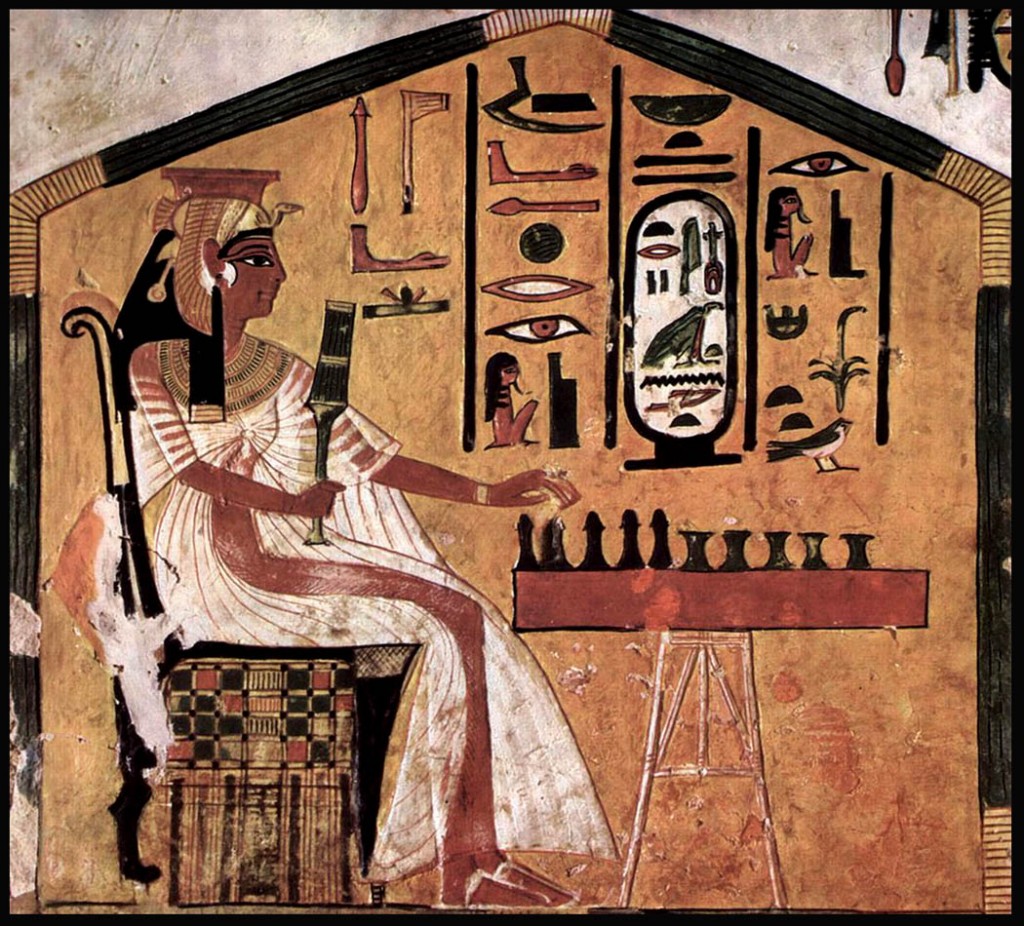 A painted depiction of Senet (in the tomb of Queen Nefertari, Valley of the Queens, Thebes, Egypt), one of the world’s earliest known board games.
A painted depiction of Senet (in the tomb of Queen Nefertari, Valley of the Queens, Thebes, Egypt), one of the world’s earliest known board games.
Maler der Grabkammer der Nefertari – The Yorck Project: 10.000 Meisterwerke der Malerei. DVD-ROM, 2002. ISBN 3936122202. Distributed by DIRECTMEDIA Publishing GmbH.
File:Maler der Grabkammer der Nefertari 003.jpg, Uploaded by File Upload Bot (Eloquence), Created: circa 1298-1235 BCE
Most ancient Egyptians were farmers tied to the land. Their dwellings were restricted to immediate family members, and were constructed of mud-brick designed to remain cool in the heat of the day. Each home had a kitchen with an open roof, which contained a grindstone for milling grain and a small oven for baking the bread.[145] Walls were painted white and could be covered with dyed linen wall hangings. Floors were covered with reed mats, while wooden stools, beds raised from the floor and individual tables comprised the furniture.[146]
The ancient Egyptians placed a great value on hygiene and appearance. Most bathed in the Nile and used a pasty soap made from animal fat and chalk. Men shaved their entire bodies for cleanliness; perfumes and aromatic ointments covered bad odors and soothed skin.[147] Clothing was made from simple linen sheets that were bleached white, and both men and women of the upper classes wore wigs, jewelry, and cosmetics. Children went without clothing until maturity, at about age 12, and at this age males were circumcised and had their heads shaved. Mothers were responsible for taking care of the children, while the father provided the family’s income.[148]
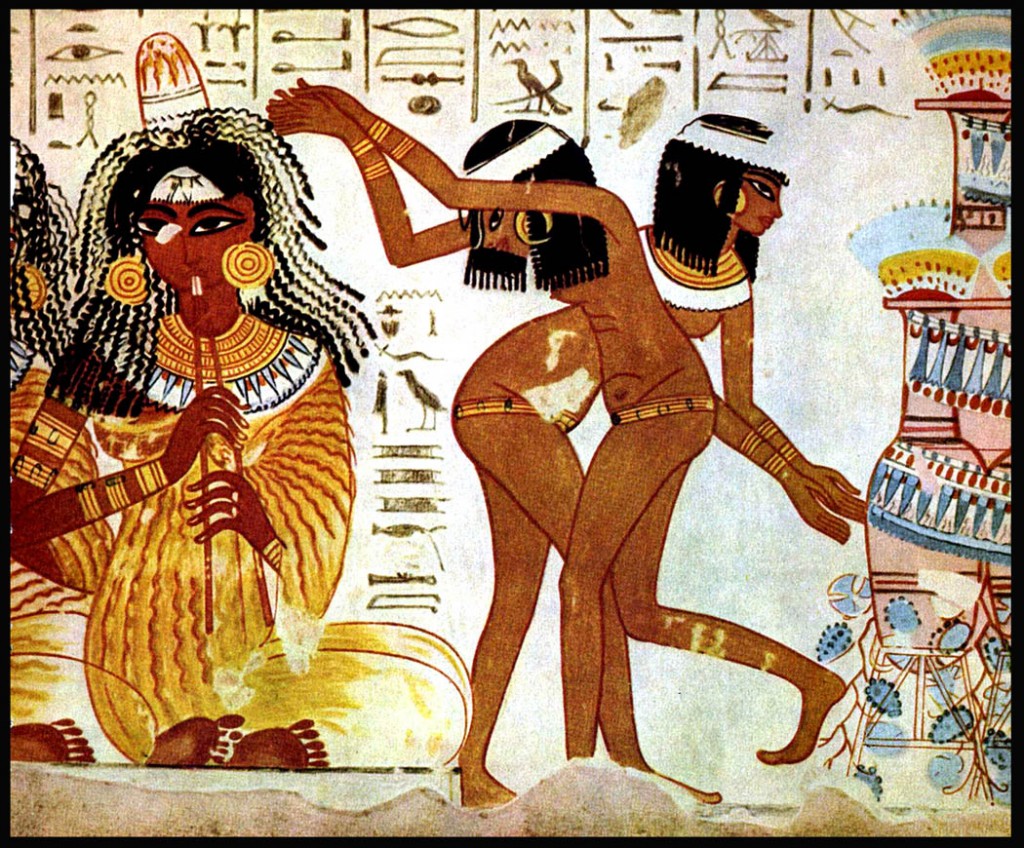 The ancient Egyptians maintained a rich cultural heritage complete with feasts and festivals accompanied by music and dance.
The ancient Egyptians maintained a rich cultural heritage complete with feasts and festivals accompanied by music and dance.
Ägyptischer Maler um 1400 v. Chr. – The Yorck Project: 10.000 Meisterwerke der Malerei. DVD-ROM, 2002. ISBN 3936122202. Distributed by DIRECTMEDIA Publishing GmbH.
File:Musicians and dancers on fresco at Tomb of Nebamun.jpg, Uploaded by Jeff Dahl, Created: 1420-1
Music and dance were popular entertainments for those who could afford them. Early instruments included flutes and harps, while instruments similar to trumpets, oboes, and pipes developed later and became popular. In the New Kingdom, the Egyptians played on bells, cymbals, tambourines, drums, and imported lutes and lyres from Asia.[149] The sistrum was a rattle-like musical instrument that was especially important in religious ceremonies.
The ancient Egyptians enjoyed a variety of leisure activities, including games and music. Senet, a board game where pieces moved according to random chance, was particularly popular from the earliest times; another similar game was mehen, which had a circular gaming board. Juggling and ball games were popular with children, and wrestling is also documented in a tomb at Beni Hasan.[150] The wealthy members of ancient Egyptian society enjoyed hunting and boating as well.
The excavation of the workers’ village of Deir el-Madinah has resulted in one of the most thoroughly documented accounts of community life in the ancient world that spans almost four hundred years. There is no comparable site in which the organisation, social interactions, working and living conditions of a community were studied in such detail.[151]
Cuisine
Egyptian cuisine remained remarkably stable over time; indeed, the cuisine of modern Egypt retains some striking similarities to the cuisine of the ancients. The staple diet consisted of bread and beer, supplemented with vegetables such as onions and garlic, and fruit such as dates and figs. Wine and meat were enjoyed by all on feast days while the upper classes indulged on a more regular basis. Fish, meat, and fowl could be salted or dried, and could be cooked in stews or roasted on a grill.[152]
 Karnak temple’s hypostyle halls are constructed with rows of thick columns supporting the roof beams.
Karnak temple’s hypostyle halls are constructed with rows of thick columns supporting the roof beams.
Jon Bodsworth – https://www.egyptarchive.co.uk/html/karnak_html/karnak_12.html
Hypostyle hall in Karnak temple
the author Jon Bodsworth would appreciate an email: jon@egyptarchive.co.uk As of March 2011,
File:Hypostyle hall, Karnak temple.jpg, Uploaded by Jeff Dahl, Created: 9-28-07
Architecture
 The well preserved Temple of Horus at Edfu is an exemplar of Egyptian architecture.
The well preserved Temple of Horus at Edfu is an exemplar of Egyptian architecture.
Steve F-E-Cameron (Merlin-UK) – My photograph
Approach and first pylon – Temple of Horus @ Edfu
CC BY-SA 3.0, File:S F-E-CAMERON EGYPT 2006 FEB 00289.JPG, Uploaded by Merlin-UK, Created: 31 December 2005
The architecture of ancient Egypt includes some of the most famous structures in the world: the Great Pyramids of Giza and the temples at Thebes. Building projects were organized and funded by the state for religious and commemorative purposes, but also to reinforce the power of the pharaoh. The ancient Egyptians were skilled builders; using simple but effective tools and sighting instruments, architects could build large stone structures with accuracy and precision.[153]
The domestic dwellings of elite and ordinary Egyptians alike were constructed from perishable materials such as mud bricks and wood, and have not survived. Peasants lived in simple homes, while the palaces of the elite were more elaborate structures. A few surviving New Kingdom palaces, such as those in Malkata and Amarna, show richly decorated walls and floors with scenes of people, birds, water pools, deities and geometric designs.[154] Important structures such as temples and tombs that were intended to last forever were constructed of stone instead of bricks. The architectural elements used in the world’s first large-scale stone building, Djoser‘s mortuary complex, include post and lintel supports in the papyrus and lotus motif.
The earliest preserved ancient Egyptian temples, such as those at Giza, consist of single, enclosed halls with roof slabs supported by columns. In the New Kingdom, architects added the pylon, the open courtyard, and the enclosed hypostyle hall to the front of the temple’s sanctuary, a style that was standard until the Greco-Roman period.[155] The earliest and most popular tomb architecture in the Old Kingdom was the mastaba, a flat-roofed rectangular structure of mudbrick or stone built over an underground burial chamber. The step pyramid of Djoser is a series of stone mastabas stacked on top of each other. Pyramids were built during the Old and Middle Kingdoms, but most later rulers abandoned them in favor of less conspicuous rock-cut tombs.[156] The Twenty-fifth dynasty was a notable exception, as all Twenty-fifth dynasty pharaohs constructed pyramids.[64][65][66]
Art
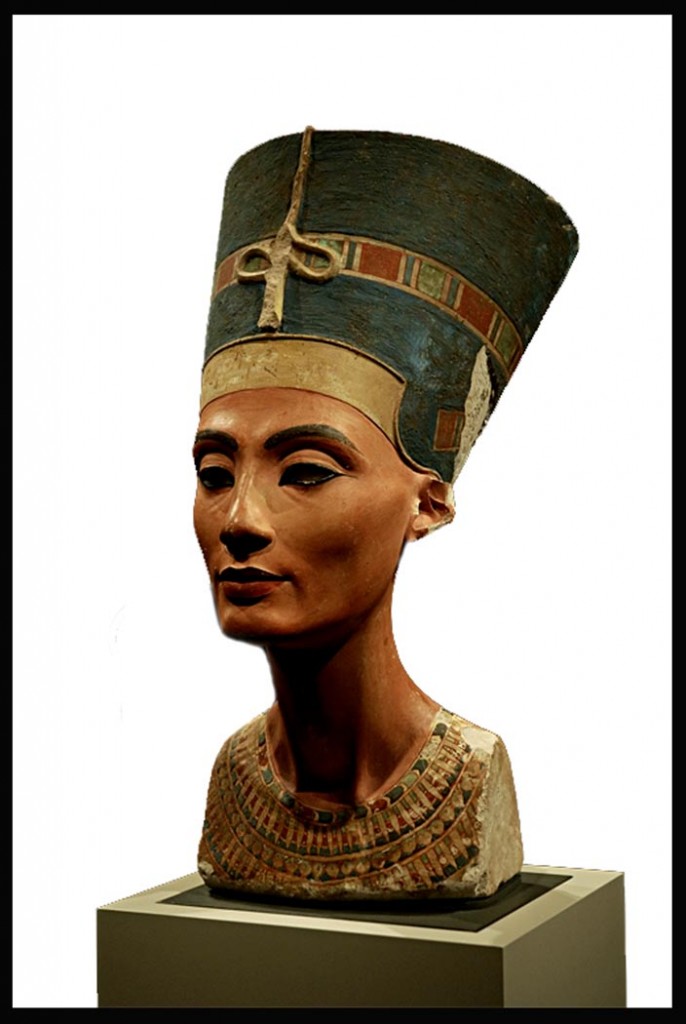 The Bust of Nefertiti, by the sculptor Thutmose, is one of the most famous masterpieces of ancient Egyptian art.
The Bust of Nefertiti, by the sculptor Thutmose, is one of the most famous masterpieces of ancient Egyptian art.
Arkadiy Etumyan – Own work
Bust of queen Nefertiti in the Neues Museum, Berlin
CC BY-SA 3.0, File:Nefertiti 30-01-2006.jpg, Uploaded by Gutza, Created: 28 January 2006
The ancient Egyptians produced art to serve functional purposes. For over 3500 years, artists adhered to artistic forms and iconography that were developed during the Old Kingdom, following a strict set of principles that resisted foreign influence and internal change.[157] These artistic standards—simple lines, shapes, and flat areas of color combined with the characteristic flat projection of figures with no indication of spatial depth—created a sense of order and balance within a composition. Images and text were intimately interwoven on tomb and temple walls, coffins, stelae, and even statues. The Narmer Palette, for example, displays figures that can also be read as hieroglyphs.[158] Because of the rigid rules that governed its highly stylized and symbolic appearance, ancient Egyptian art served its political and religious purposes with precision and clarity.[159]
Ancient Egyptian artisans used stone to carve statues and fine reliefs, but used wood as a cheap and easily carved substitute. Paints were obtained from minerals such as iron ores (red and yellow ochres), copper ores (blue and green), soot or charcoal (black), and limestone (white). Paints could be mixed with gum arabic as a binder and pressed into cakes, which could be moistened with water when needed.[160]
Pharaohs used reliefs to record victories in battle, royal decrees, and religious scenes. Common citizens had access to pieces of funerary art, such as shabti statues and books of the dead, which they believed would protect them in the afterlife.[161] During the Middle Kingdom, wooden or clay models depicting scenes from everyday life became popular additions to the tomb. In an attempt to duplicate the activities of the living in the afterlife, these models show laborers, houses, boats, and even military formations that are scale representations of the ideal ancient Egyptian afterlife.[162]
Despite the homogeneity of ancient Egyptian art, the styles of particular times and places sometimes reflected changing cultural or political attitudes. After the invasion of the Hyksos in the Second Intermediate Period, Minoan-style frescoes were found in Avaris.[163] The most striking example of a politically driven change in artistic forms comes from the Amarna period, where figures were radically altered to conform to Akhenaten‘s revolutionary religious ideas.[164] This style, known as Amarna art, was quickly and thoroughly erased after Akhenaten’s death and replaced by the traditional forms.[165]
Religious beliefs
The Book of the Dead was a guide to the deceased’s journey in the afterlife.
unknown Egyptian artisan – Jon Bodsworth (photographer)
Weighing of the heart scene, with en:Ammit sitting, from the book of the dead of Hunefer. From the source: “The judgement, from the papyrus of the scribe Hunefer. 19th Dynasty. Hunefer is conducted to the balance by jackal-headed Anubis. The monster Ammut crouches beneath the balance so as to swallow the heart should a life of wickedness be indicated. EA9901.” Anubis conducts the weighing on the scale of Maat, against the feather of truth. The ibis-headed Thoth, scribe of the gods, records the result. If his heart is lighter than the feather, Hunefer is allowed to pass into the afterlife. If not, he is eaten by the waiting chimeric devouring creature Ammit, which is composed of the deadly crocodile, lion, and hippopotamus. In the next panel, showing the scene after the weighing, a triumphant Hunefer, having passed the test, is presented by falcon-headed Horus to the shrine of the green-skinned Osiris, god of the underworld and the dead, accompanied by Isis and Nephthys. The 14 gods of Egypt are shown seated above, in the order of judges.
File:BD Hunefer.jpg, Uploaded by Jeff Dahl, Created: 8 December 2007
Beliefs in the divine and in the afterlife were ingrained in ancient Egyptian civilization from its inception; pharaonic rule was based on the divine right of kings. The Egyptian pantheon was populated by gods who had supernatural powers and were called on for help or protection. However, the gods were not always viewed as benevolent, and Egyptians believed they had to be appeased with offerings and prayers. The structure of this pantheon changed continually as new deities were promoted in the hierarchy, but priests made no effort to organize the diverse and sometimes conflicting myths and stories into a coherent system.[166] These various conceptions of divinity were not considered contradictory but rather layers in the multiple facets of reality.[167]
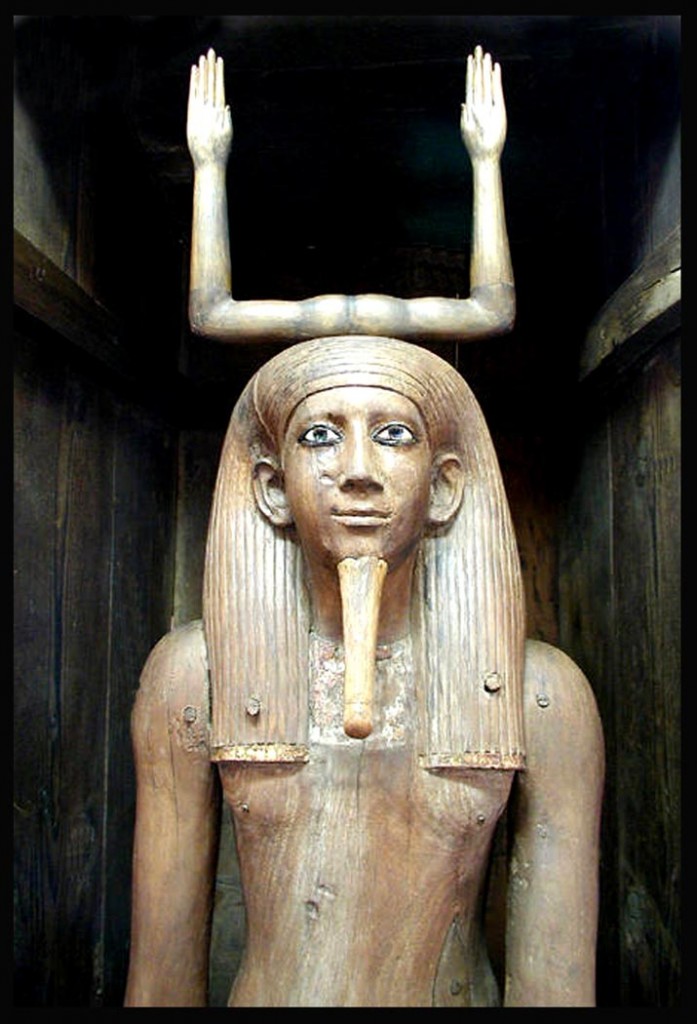 The Ka statue provided a physical place for the Ka to manifest
The Ka statue provided a physical place for the Ka to manifest
The Ka statue provided a physical place for the Ka to manifest
Jon Bodsworth – https://www.egyptarchive.co.uk/html/cairo_museum_24.html
Ka statue of Horawibra – (Pharaoh w:Hor)
the author Jon Bodsworth would appreciate an email: jon@egyptarchive.co.uk As of March 2011
File:Ka Statue of horawibra.jpg, Uploaded by Jeff Dahl, Created: 10 December 2007
Gods were worshiped in cult temples administered by priests acting on the king’s behalf. At the center of the temple was the cult statue in a shrine. Temples were not places of public worship or congregation, and only on select feast days and celebrations was a shrine carrying the statue of the god brought out for public worship. Normally, the god’s domain was sealed off from the outside world and was only accessible to temple officials. Common citizens could worship private statues in their homes, and amulets offered protection against the forces of chaos.[168] After the New Kingdom, the pharaoh’s role as a spiritual intermediary was de-emphasized as religious customs shifted to direct worship of the gods. As a result, priests developed a system of oracles to communicate the will of the gods directly to the people.[169]
The Egyptians believed that every human being was composed of physical and spiritual parts or aspects. In addition to the body, each person had a šwt (shadow), a ba (personality or soul), a ka (life-force), and a name.[170] The heart, rather than the brain, was considered the seat of thoughts and emotions. After death, the spiritual aspects were released from the body and could move at will, but they required the physical remains (or a substitute, such as a statue) as a permanent home. The ultimate goal of the deceased was to rejoin his ka and ba and become one of the “blessed dead”, living on as an akh, or “effective one”. For this to happen, the deceased had to be judged worthy in a trial, in which the heart was weighed against a “feather of truth”. If deemed worthy, the deceased could continue their existence on earth in spiritual form.[171]
Pharaohs’ tombs were provided with vast quantities of wealth, such as this golden mask from the mummy of Tutankhamun.
Jon Bodsworth – https://www.egyptarchive.co.uk/html/cairo_museum_54.html
Golden funeral mask of king Tutankham
The author Jon Bodsworth would appreciate an email: jon@egyptarchive.co.uk As of March 2011
File:Tutmask.jpg, Uploaded by Robors, Created: 10 December 2007
Burial customs
Ancient Egyptian burial customs
The ancient Egyptians maintained an elaborate set of burial customs that they believed were necessary to ensure immortality after death. These customs involved preserving the body by mummification, performing burial ceremonies, and interring with the body goods the deceased would use in the afterlife.[161] Before the Old Kingdom, bodies buried in desert pits were naturally preserved by desiccation. The arid, desert conditions were a boon throughout the history of ancient Egypt for burials of the poor, who could not afford the elaborate burial preparations available to the elite. Wealthier Egyptians began to bury their dead in stone tombs and use artificial mummification, which involved removing the internal organs, wrapping the body in linen, and burying it in a rectangular stone sarcophagus or wooden coffin. Beginning in the Fourth Dynasty, some parts were preserved separately in canopic jars.[172]
 Anubis was the ancient Egyptian god associated with mummification and burial rituals; here, he attends to a mummy.
Anubis was the ancient Egyptian god associated with mummification and burial rituals; here, he attends to a mummy.
self – website
Picture of wall painting from the tomb of Sennedjem. Anubis attending the mummy of the deceased.
File:Anubis attending the mummy of Sennedjem.jpg, Uploaded by Jeff Dahl, Created: 9-13-07
By the New Kingdom, the ancient Egyptians had perfected the art of mummification; the best technique took 70 days and involved removing the internal organs, removing the brain through the nose, and desiccating the body in a mixture of salts called natron. The body was then wrapped in linen with protective amulets inserted between layers and placed in a decorated anthropoid coffin. Mummies of the Late Period were also placed in painted cartonnage mummy cases. Actual preservation practices declined during the Ptolemaic and Roman eras, while greater emphasis was placed on the outer appearance of the mummy, which was decorated.[173]
Wealthy Egyptians were buried with larger quantities of luxury items, but all burials, regardless of social status, included goods for the deceased. Beginning in the New Kingdom, books of the dead were included in the grave, along with shabti statues that were believed to perform manual labor for them in the afterlife.[174] Rituals in which the deceased was magically re-animated accompanied burials. After burial, living relatives were expected to occasionally bring food to the tomb and recite prayers on behalf of the deceased.[175]
Military
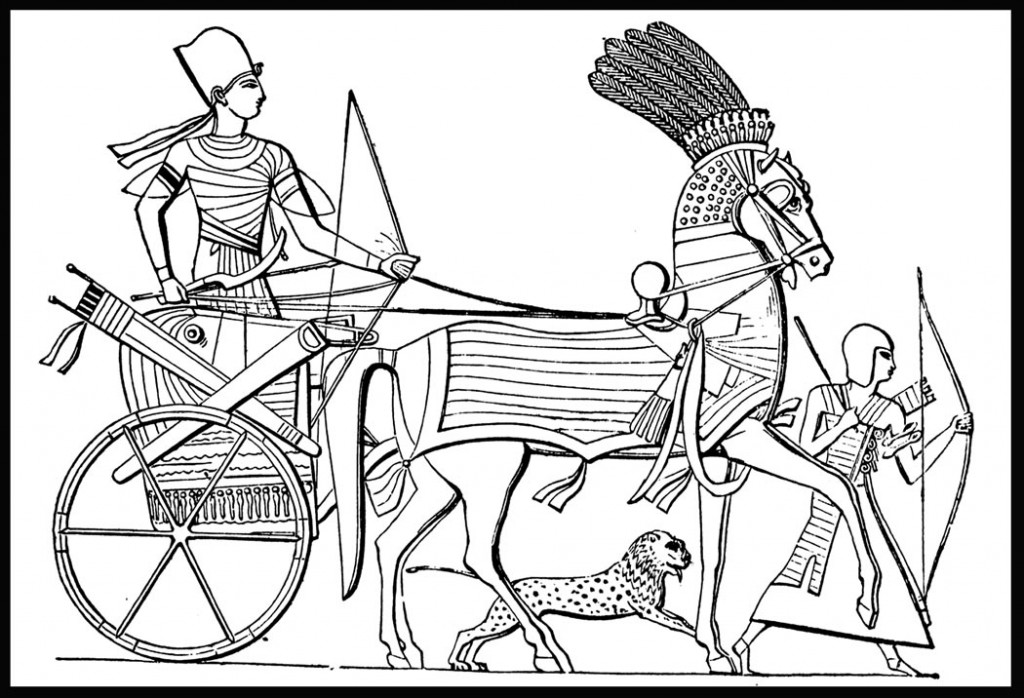 An Egyptian chariot.
An Egyptian chariot.
Joseph Bonomi – Scanned from Nineveh and Its Palaces, by Joseph Bonomi, figure 108
Egyptian Chariot, Char Egyptien
File:Egyptian-Chariot.png, Uploaded by Bf5man, Created: 31 December 1852,
The ancient Egyptian military was responsible for defending Egypt against foreign invasion, and for maintaining Egypt’s domination in the ancient Near East. The military protected mining expeditions to the Sinai during the Old Kingdom and fought civil wars during the First and Second Intermediate Periods. The military was responsible for maintaining fortifications along important trade routes, such as those found at the city of Buhen on the way to Nubia. Forts also were constructed to serve as military bases, such as the fortress at Sile, which was a base of operations for expeditions to the Levant. In the New Kingdom, a series of pharaohs used the standing Egyptian army to attack and conquer Kush and parts of the Levant.[176]
Typical military equipment included bows and arrows, spears, and round-topped shields made by stretching animal skin over a wooden frame. In the New Kingdom, the military began using chariots that had earlier been introduced by the Hyksos invaders. Weapons and armor continued to improve after the adoption of bronze: shields were now made from solid wood with a bronze buckle, spears were tipped with a bronze point, and the Khopesh was adopted from Asiatic soldiers.[177] The pharaoh was usually depicted in art and literature riding at the head of the army; it has been suggested that at least a few pharaohs, such as Seqenenre Tao II and his sons, did do so.[178] However, it has also been argued that “kings of this period did not personally act as frontline war leaders, fighting alongside their troops.”[179] Soldiers were recruited from the general population, but during, and especially after, the New Kingdom, mercenaries from Nubia, Kush, and Libya were hired to fight for Egypt.[180]
Technology, medicine, and mathematics
Technology
In technology, medicine and mathematics, ancient Egypt achieved a relatively high standard of productivity and sophistication. Traditional empiricism, as evidenced by the Edwin Smith and Ebers papyri (c. 1600 BC), is first credited to Egypt. The Egyptians created their own alphabet and decimal system.
Glassmaking was a highly developed art.
Jon Bodsworth – https://www.egyptarchive.co.uk/html/louvre_museum/louvre_museum_frame.html
Ancient Egyptian glass jar from the New Kingdom. Matériaux : Pâte de verre.
the author Jon Bodsworth would appreciate an email: jon@egyptarchive.co.uk As of March 2011
File:Egyptian glass jar.jpg, Uploaded by Jeff Dahl, Created: 8 December 2007
Faience and glass
Even before the Old Kingdom, the ancient Egyptians had developed a glassy material known as faience, which they treated as a type of artificial semi-precious stone. Faience is a non-clay ceramic made of silica, small amounts of lime and soda, and a colorant, typically copper.[181] The material was used to make beads, tiles, figurines, and small wares. Several methods can be used to create faience, but typically production involved application of the powdered materials in the form of a paste over a clay core, which was then fired. By a related technique, the ancient Egyptians produced a pigment known as Egyptian Blue, also called blue frit, which is produced by fusing (or sintering) silica, copper, lime, and an alkali such as natron. The product can be ground up and used as a pigment.[182]
The ancient Egyptians could fabricate a wide variety of objects from glass with great skill, but it is not clear whether they developed the process independently.[183] It is also unclear whether they made their own raw glass or merely imported pre-made ingots, which they melted and finished. However, they did have technical expertise in making objects, as well as adding trace elements to control the color of the finished glass. A range of colors could be produced, including yellow, red, green, blue, purple, and white, and the glass could be made either transparent or opaque.[184]
Medicine
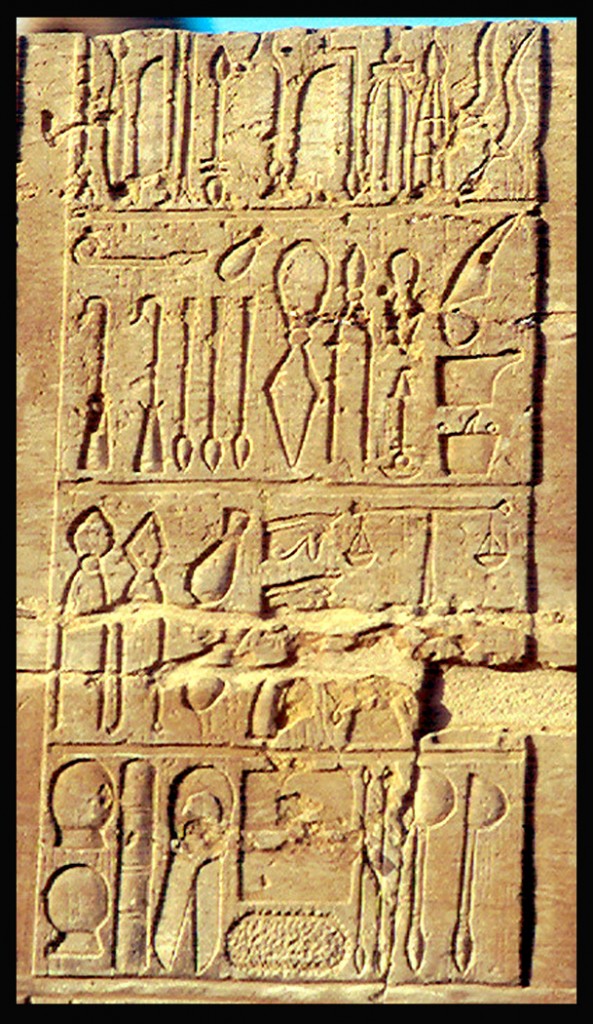 Ancient Egyptian medical instruments depicted in a Ptolemaic period inscription on the temple at Kom Ombo.
Ancient Egyptian medical instruments depicted in a Ptolemaic period inscription on the temple at Kom Ombo.
Jeff Dahl – self-made, taken May 2005
Inscription detailing ancient Egyptian medical instruments, including bone saws, suction cups, knives and scalpels, retractors, scales, lances, chisels and dental tools.
CC BY-SA 3.0, File:Ancient Egyptian medical instruments.jpg, Uploaded by JMCC1, Created: 7 May 0010
The medical problems of the ancient Egyptians stemmed directly from their environment. Living and working close to the Nile brought hazards from malaria and debilitating schistosomiasis parasites, which caused liver and intestinal damage. Dangerous wildlife such as crocodiles and hippos were also a common threat. The lifelong labors of farming and building put stress on the spine and joints, and traumatic injuries from construction and warfare all took a significant toll on the body. The grit and sand from stone-ground flour abraded teeth, leaving them susceptible to abscesses (though caries were rare).[185]
The diets of the wealthy were rich in sugars, which promoted periodontal disease.[186] Despite the flattering physiques portrayed on tomb walls, the overweight mummies of many of the upper class show the effects of a life of overindulgence.[187] Adult life expectancy was about 35 for men and 30 for women, but reaching adulthood was difficult as about one-third of the population died in infancy.[188]
Ancient Egyptian physicians were renowned in the ancient Near East for their healing skills, and some, such as Imhotep, remained famous long after their deaths.[189] Herodotus remarked that there was a high degree of specialization among Egyptian physicians, with some treating only the head or the stomach, while others were eye-doctors and dentists.[190] Training of physicians took place at the Per Ankh or “House of Life” institution, most notably those headquartered in Per-Bastet during the New Kingdom and at Abydos and Saïs in the Late period. Medical papyri show empirical knowledge of anatomy, injuries, and practical treatments.[191]
Wounds were treated by bandaging with raw meat, white linen, sutures, nets, pads, and swabs soaked with honey to prevent infection,[192] while opium thyme and belladona were used to relieve pain. The earliest records of burn treatment describe burn dressings that use the milk from mothers of male babies. Prayers were made to the goddess Isis. Moldy bread, honey and copper salts were also used to prevent infection from dirt in burns.[193] Garlic and onions were used regularly to promote good health and were thought to relieve asthma symptoms. Ancient Egyptian surgeons stitched wounds, set broken bones, and amputated diseased limbs, but they recognized that some injuries were so serious that they could only make the patient comfortable until death occurred.[194]
Shipbuilding
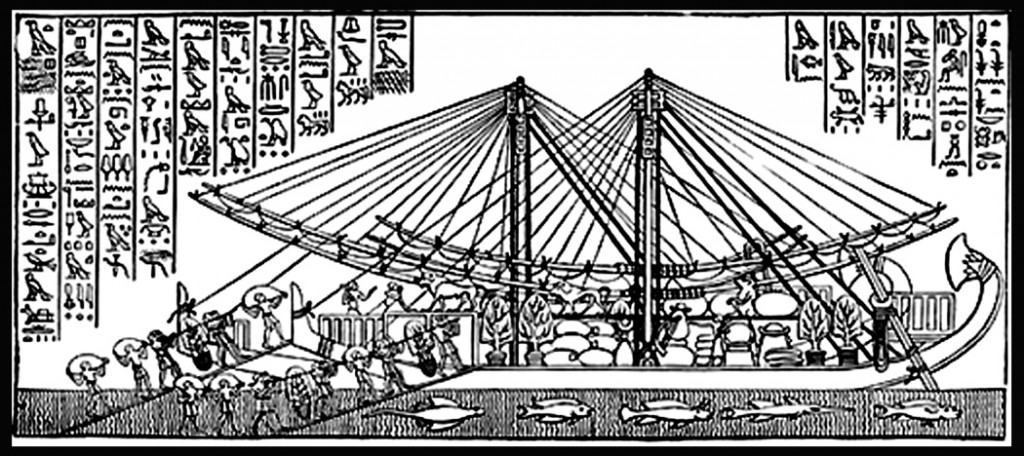 Seagoing ship from Hateshepsut’s Deir el-Bahari temple relief of a Punt Expedition
Seagoing ship from Hateshepsut’s Deir el-Bahari temple relief of a Punt Expedition
Hateshepsut Deir-Bahari temple wall relief – Memphis University Press
File:Ancient Egyptian Seafaring Ship.jpg, Uploaded by VitoPisani, Created: 29 April 2014
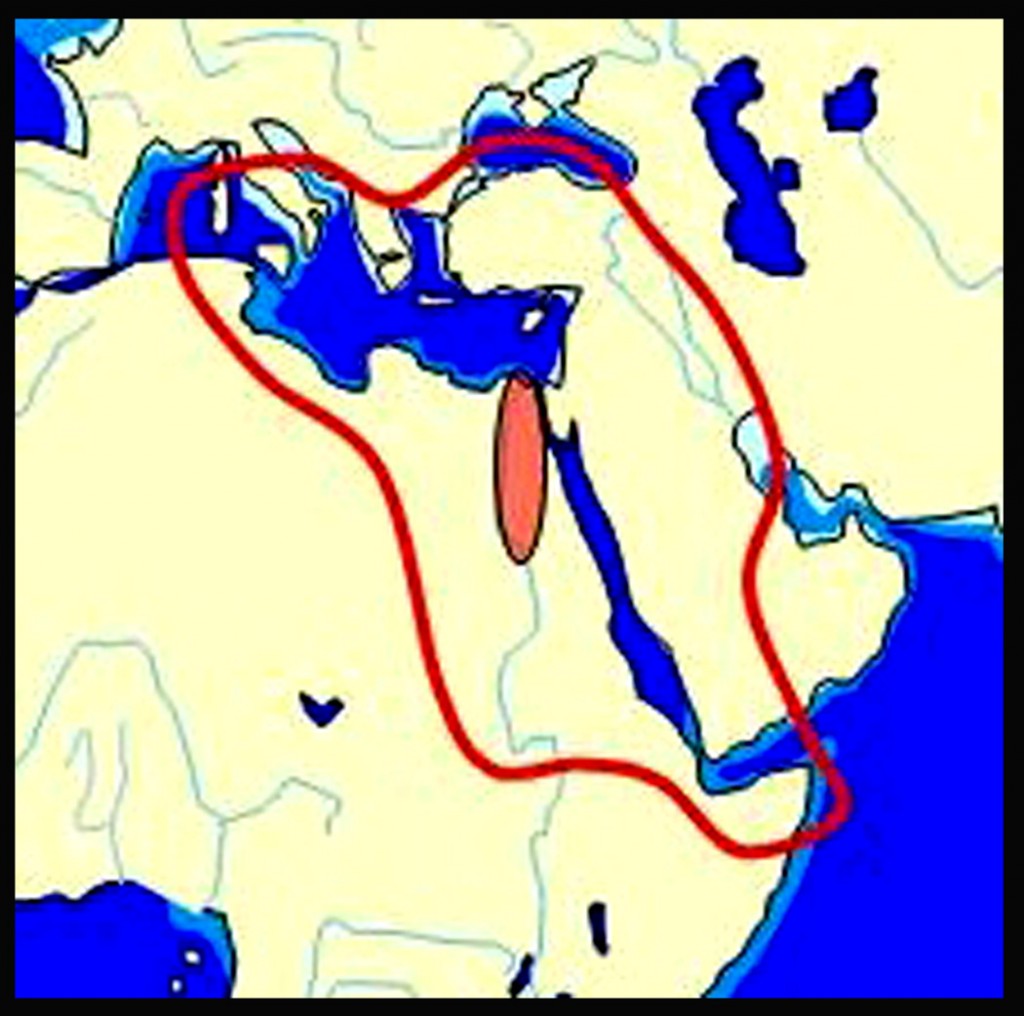 Documented extent of Ancient Egyptian geographic knowledge
Documented extent of Ancient Egyptian geographic knowledge
John D. Croft – Own work
CC BY-SA 3.0, File:Language Maps Known Egyptian World 1.jpg, Uploaded by John D. Croft, Created: 13 January 2014
Early Egyptians knew how to assemble planks of wood into a ship hull and had mastered advanced forms of shipbuilding as early as 3000 BC. The Archaeological Institute of America reports that some of the oldest ships yet unearthed are known as the Abydos boats.[6] These are a group of 14 discovered ships in Abydos that were constructed of wooden planks “sewn” together. Discovered by Egyptologist David O’Connor of New York University,[195] woven straps were found to have been used to lash the planks together,[6] and reeds or grass stuffed between the planks helped to seal the seams.[6] Because the ships are all buried together and near a mortuary belonging to Pharaoh Khasekhemwy, originally they were all thought to have belonged to him, but one of the 14 ships dates to 3000 BC, and the associated pottery jars buried with the vessels also suggest earlier dating. The ship dating to 3000 BC was 75 feet (23 m) long and is now thought to perhaps have belonged to an earlier pharaoh. According to professor O’Connor, the 5,000-year-old ship may have even belonged to Pharaoh Aha.[195]
Early Egyptians also knew how to assemble planks of wood with treenails to fasten them together, using pitch for caulking the seams. The “Khufu ship“, a 43.6-metre (143 ft) vessel sealed into a pit in the Giza pyramid complex at the foot of the Great Pyramid of Giza in the Fourth Dynasty around 2500 BC, is a full-size surviving example that may have filled the symbolic function of a solar barque. Early Egyptians also knew how to fasten the planks of this ship together with mortise and tenon joints.[6]
Large seagoing ships are known to have been heavily used by the Egyptians in their trade with the city states of the eastern Mediterranean, especially Byblos (on the coast of modern-day Lebanon), and in several expeditions down the Red Sea to the Land of Punt.[196] In fact one of the earliest Egyptian words for a seagoing ship is a “Byblos Ship”, which originally defined a class of Egyptian seagoing ships used on the Byblos run; however, by the end of the Old Kingdom, the term had come to include large seagoing ships, whatever their destination.[197]
In 2011 archaeologists from Italy, the United States, and Egypt excavating a dried-up lagoon known as Mersa Gawasis have unearthed traces of an ancient harbor that once launched early voyages like Hatshepsut‘s Punt expedition onto the open ocean.[198] Some of the site’s most evocative evidence for the ancient Egyptians’ seafaring prowess include large ship timbers and hundreds of feet of ropes, made from papyrus, coiled in huge bundles.[198] And in 2013 a team of Franco-Egyptian archaeologists discovered what is believed to be the world’s oldest port, dating back about 4500 years, from the time of King Cheops on the Red Sea coast near Wadi el-Jarf (about 110 miles south of Suez).[199]
Mathematics
Astronomical chart in Senemut’s tomb, 18th dynasty[200]
NebMaatRa – selbst
Kalendereinteilung im Grab des Senenmut (TT353); astronomical ceiling in the tomb of Senenmut (TT353)
GPLview terms, File:Senenmut-Grab.JPG, Uploaded by NebMaatRa, Created: 25 July 2008
The earliest attested examples of mathematical calculations date to the predynastic Naqada period, and show a fully developed numeral system.[201] The importance of mathematics to an educated Egyptian is suggested by a New Kingdom fictional letter in which the writer proposes a scholarly competition between himself and another scribe regarding everyday calculation tasks such as accounting of land, labor, and grain.[202] Texts such as the Rhind Mathematical Papyrus and the Moscow Mathematical Papyrus show that the ancient Egyptians could perform the four basic mathematical operations—addition, subtraction, multiplication, and division—use fractions, compute the volumes of boxes and pyramids, and calculate the surface areas of rectangles, triangles, and circles. They understood basic concepts of algebra and geometry, and could solve simple sets of simultaneous equations.[203]
Mathematical notation was decimal, and based on hieroglyphic signs for each power of ten up to one million. Each of these could be written as many times as necessary to add up to the desired number; so to write the number eighty or eight hundred, the symbol for ten or one hundred was written eight times respectively.[204] Because their methods of calculation could not handle most fractions with a numerator greater than one, they had to write fractions as the sum of several fractions. For example, they resolved the fraction two-fifths into the sum of one-third + one-fifteenth. Standard tables of values facilitated this.[205] Some common fractions, however, were written with a special glyph—the equivalent of the modern two-thirds is shown on the right.[206]
Ancient Egyptian mathematicians had a grasp of the principles underlying the Pythagorean theorem, knowing, for example, that a triangle had a right angle opposite the hypotenuse when its sides were in a 3–4–5 ratio.[207] They were able to estimate the area of a circle by subtracting one-ninth from its diameter and squaring the result:
Area ? [(8?9)D]2 = (256?81)r 2 ? 3.16r 2,
a reasonable approximation of the formula ?r 2.[207][208]
The golden ratio seems to be reflected in many Egyptian constructions, including the pyramids, but its use may have been an unintended consequence of the ancient Egyptian practice of combining the use of knotted ropes with an intuitive sense of proportion and harmony.[209]
Legacy
Tourists riding a bactrian camel (Camelus bactrianus) in front of Pyramid of Khafre. The pyramid of Menkaure is on background.
kallerna – Own work
CC BY-SA 3.0, File:Camel and the pyramids.jpg, Uploaded by Kallerna, Created: 31 December 2009
Frontispiece of Description de l’Égypte, published in 38 volumes and published by the French government from 1809-1823.
The original uploader was SnowFire at English Wikipedia – https://www.daheshmuseum.org/collection/gr/egyptFrontispiece_a.jpg
EgyptFrontispiece.jpg, Uploaded by Misa123a, Created: 13 November 2006
The culture and monuments of ancient Egypt have left a lasting legacy on the world. The cult of the goddess Isis, for example, became popular in the Roman Empire, as obelisks and other relics were transported back to Rome.[210] The Romans also imported building materials from Egypt to erect Egyptian-style structures. Early historians such as Herodotus, Strabo, and Diodorus Siculus studied and wrote about the land, which Romans came to view as a place of mystery.[211]
During the Middle Ages and The Renaissance, Egyptian pagan culture was in decline after the rise of Christianity and later Islam, but interest in Egyptian antiquity continued in the writings of medieval scholars such as Dhul-Nun al-Misri and al-Maqrizi.[212] In the seventeenth and eighteenth centuries, European travelers and tourists brought back antiquities and wrote stories of their journeys, leading to a wave of Egyptomania across Europe. This renewed interest sent collectors to Egypt, who took, purchased, or were given many important antiquities.[213]
Although the European colonial occupation of Egypt destroyed a significant portion of the country’s historical legacy, some foreigners had more positive results. Napoleon, for example, arranged the first studies in Egyptology when he brought some 150 scientists and artists to study and document Egypt’s natural history, which was published in the Description de l’?gypte.[214]
In the 20th century AD, the Egyptian Government and archaeologists alike recognized the importance of cultural respect and integrity in excavations. The Supreme Council of Antiquities now approves and oversees all excavations, which are aimed at finding information rather than treasure. The council also supervises museums and monument reconstruction programs designed to preserve the historical legacy of Egypt.
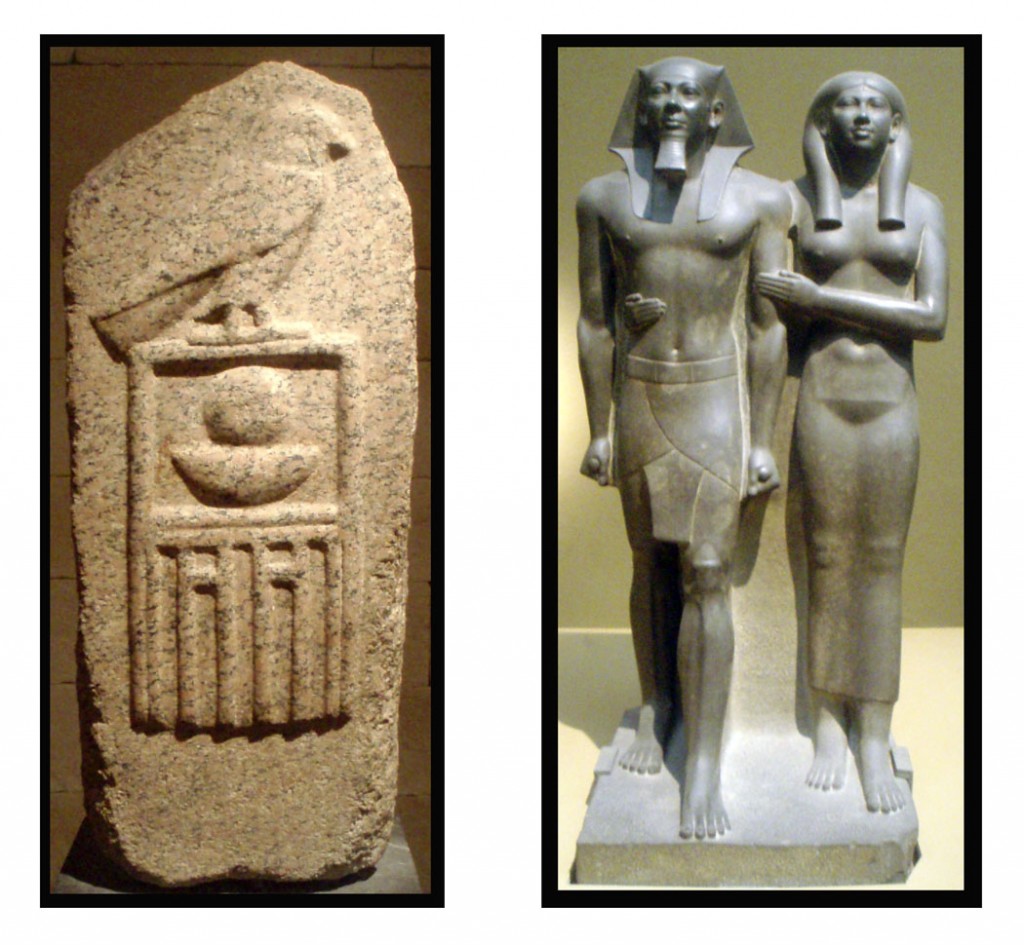 Left: Early Dynastic Period of Egypt Stela of the 2nd dynasty pharaoh Raneb, displaying the hieroglyph for his name within a serekh, surmounted by Horus. On display at the Metropolitan Museum of Art.Stela of the 2nd dynasty pharaoh Raneb, displaying the hieroglyph for his name within a serekh, surmounted by Horus. On display at the Metropolitan Museum of Art. Keith Schengili-Roberts – Own Work (photo)
Left: Early Dynastic Period of Egypt Stela of the 2nd dynasty pharaoh Raneb, displaying the hieroglyph for his name within a serekh, surmounted by Horus. On display at the Metropolitan Museum of Art.Stela of the 2nd dynasty pharaoh Raneb, displaying the hieroglyph for his name within a serekh, surmounted by Horus. On display at the Metropolitan Museum of Art. Keith Schengili-Roberts – Own Work (photo)
Right: Old Kingdom, Graywacke statue of the pharaoh Menkaura and his consort Queen Khamerernebty II. Originally from his Giza Valley temple, now on display at the Museum of Fine Arts, Boston.Graywacke statue of the pharaoh Menkaura and his consort Queen Khamerernebty II. Originally from his Giza Valley temple, now on display at the Museum of Fine Arts, Boston. Keith Schengili-Roberts – Own work (photo)
Left: Pottery model of a house used in a burial from the First Intermediate Period, on display at the Royal Ontario Museum. Keith Schengili-Roberts – Own Work (photo)
Right: Sphinx of the Nubian pharaoh Taharqa. Udimu (Own work)
Left: An Osiride statue of Mentuhotep II, the founder of the Middle Kingdom, Jon Bodsworth – https://www.egyptarchive.co.uk/html/cairo_museum_22.html
Right: Statuette of Merankhre Mentuhotep VI, a minor king of the 16th Dynasty, reigning over the Theban region c. 1585 BC. Juan R. Lazaro – Photo by Juan R. Lazaro,
Egypt and its world in 1300 BC. Talessman at English Wikipedia
The Great Pyramid (Kheops pyramid). Alex lbh – Own work
For more information please visit the following links:
https://en.wikipedia.org/wiki/Ancient_Egypt
https://en.wikipedia.org/wiki/History_of_ancient_Egypt
https://en.wikipedia.org/wiki/Mortuary_Temple_of_Hatshepsut
Glossary of ancient Egypt artifacts
Index of ancient Egypt-related articles
Toynbee’s law of challenge and response
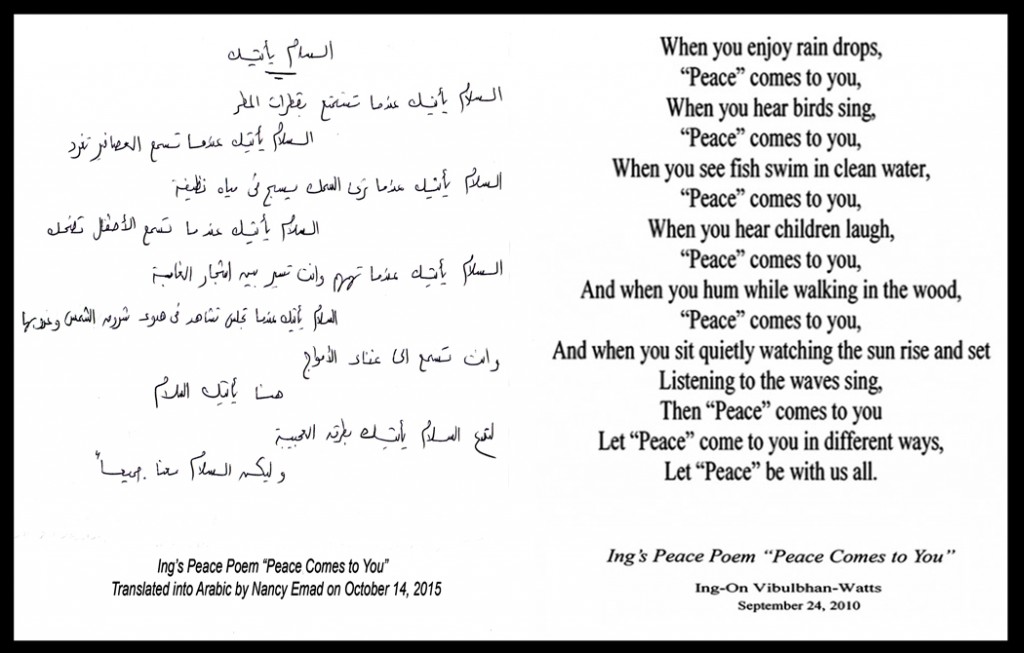

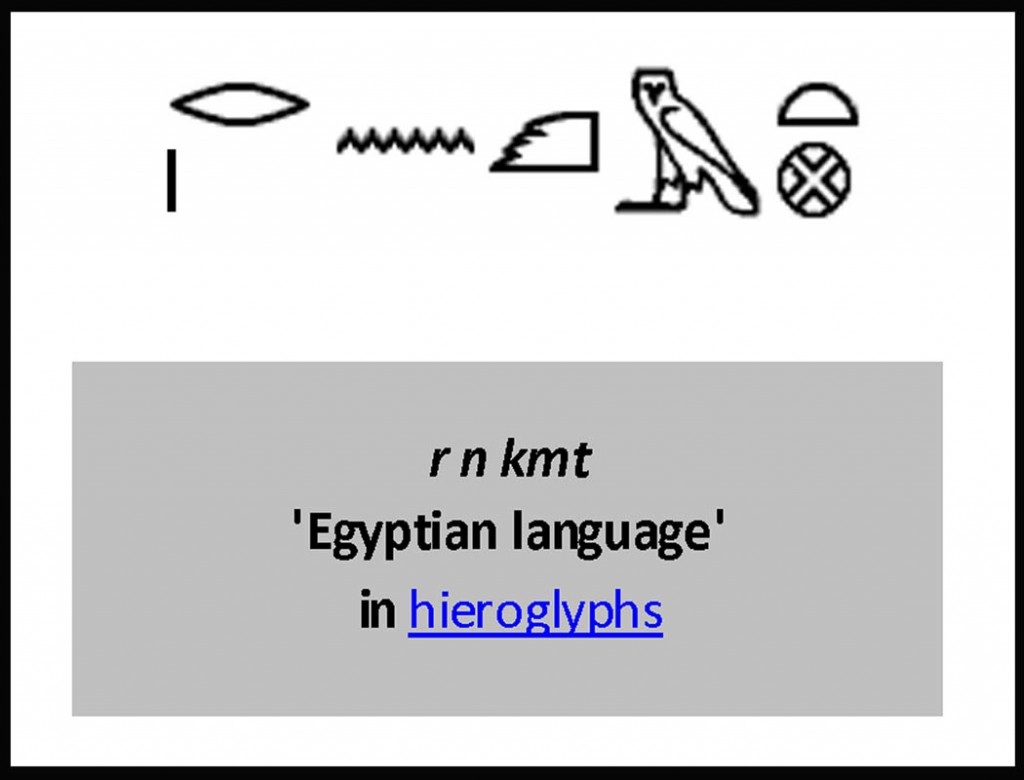
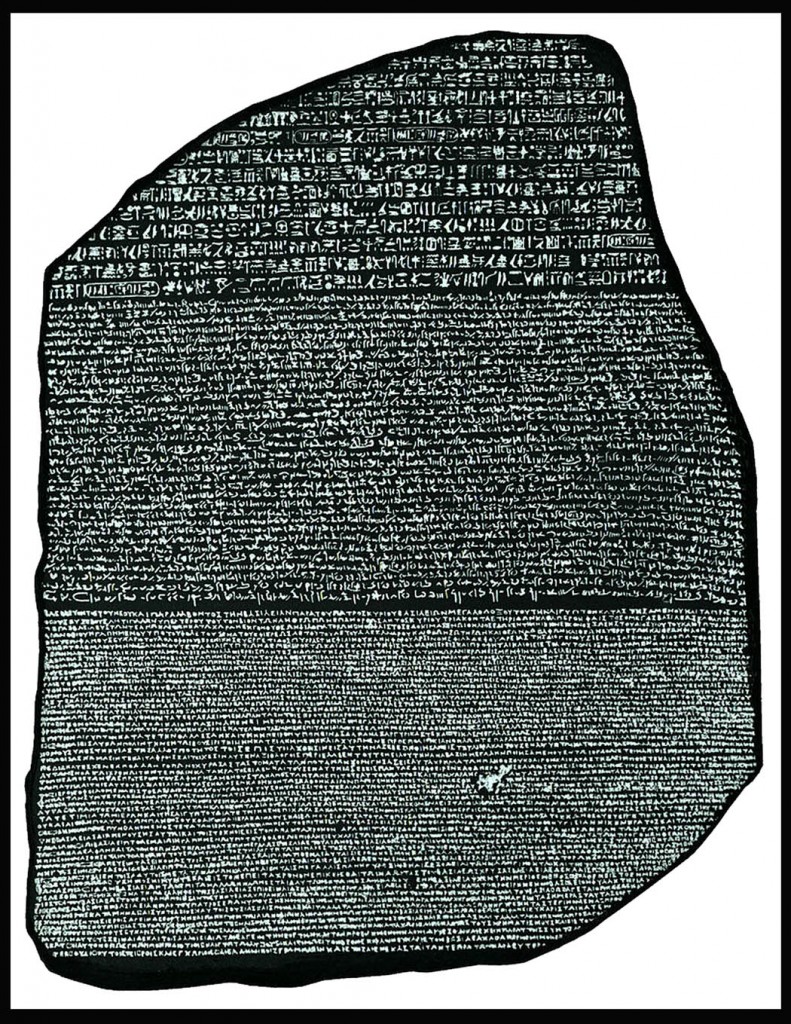
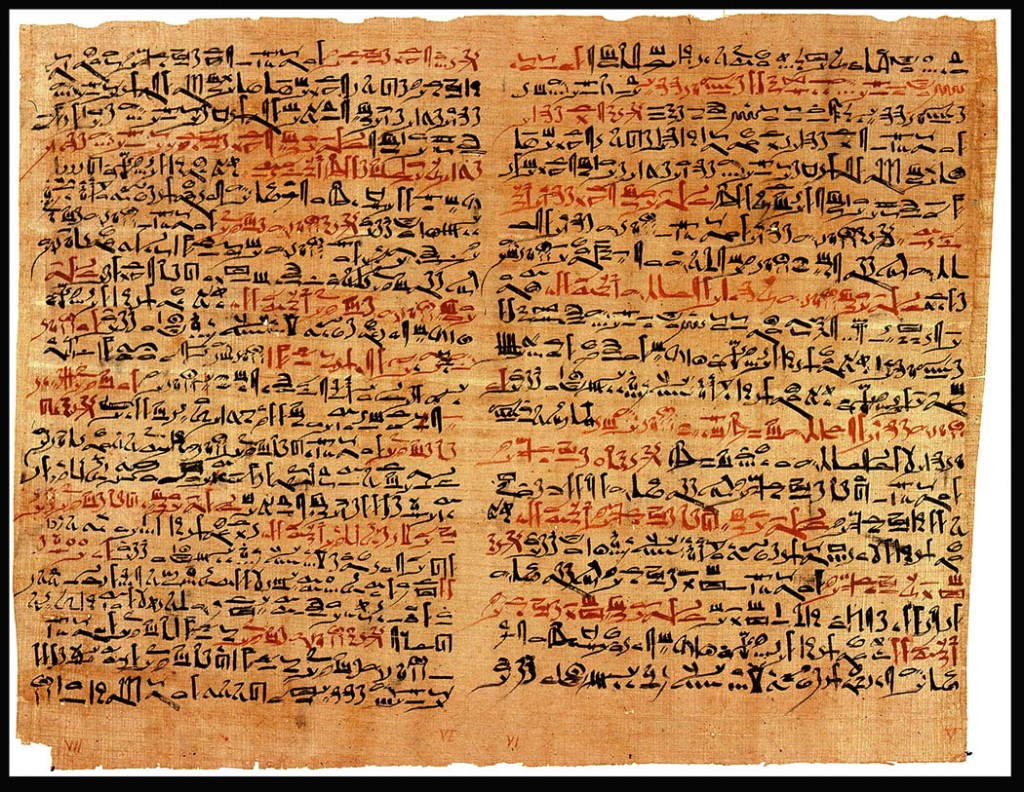
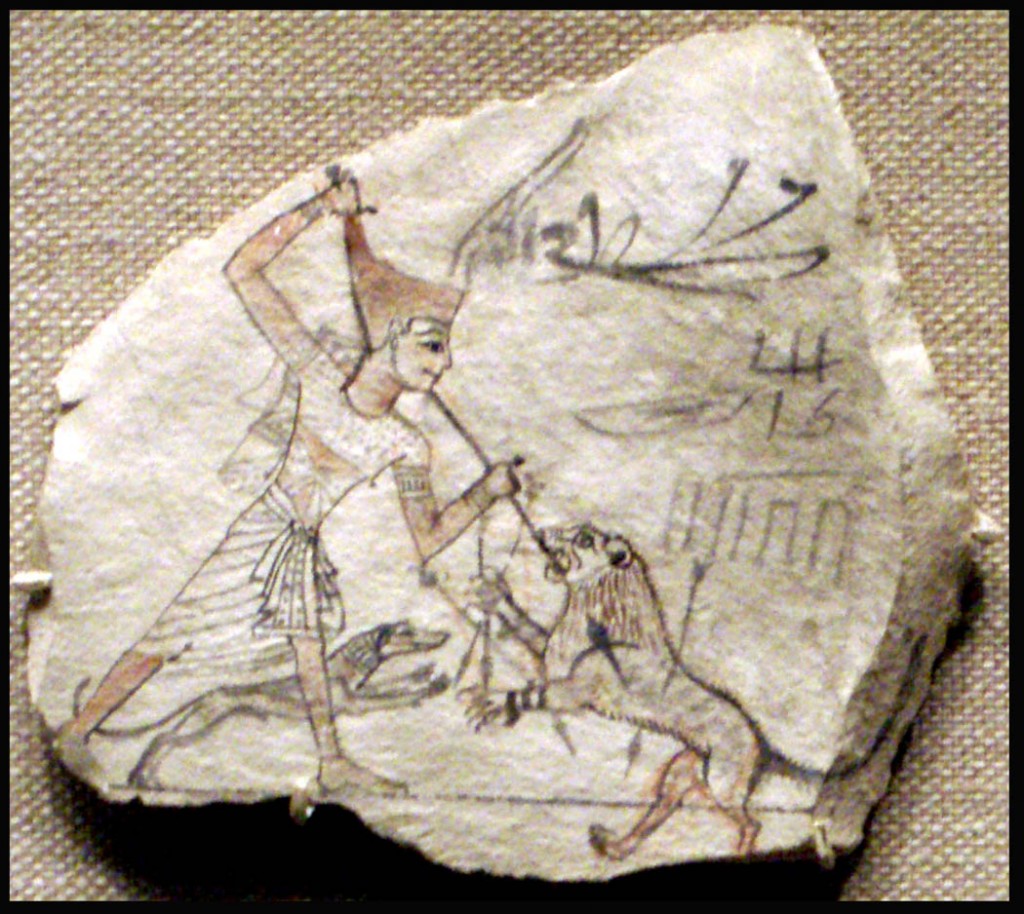
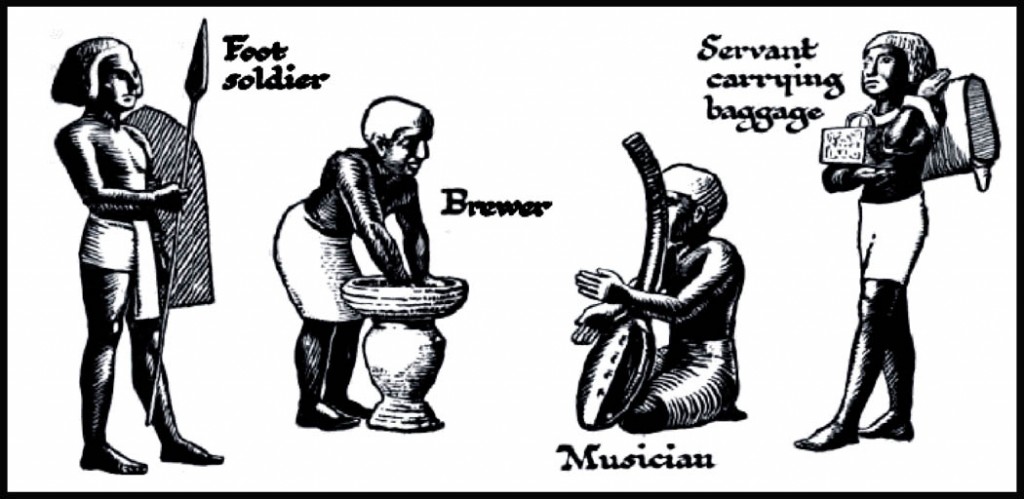
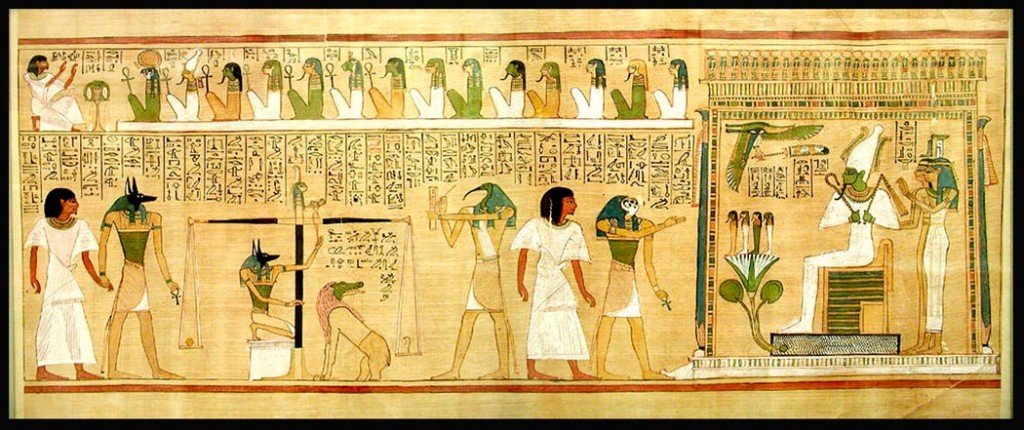
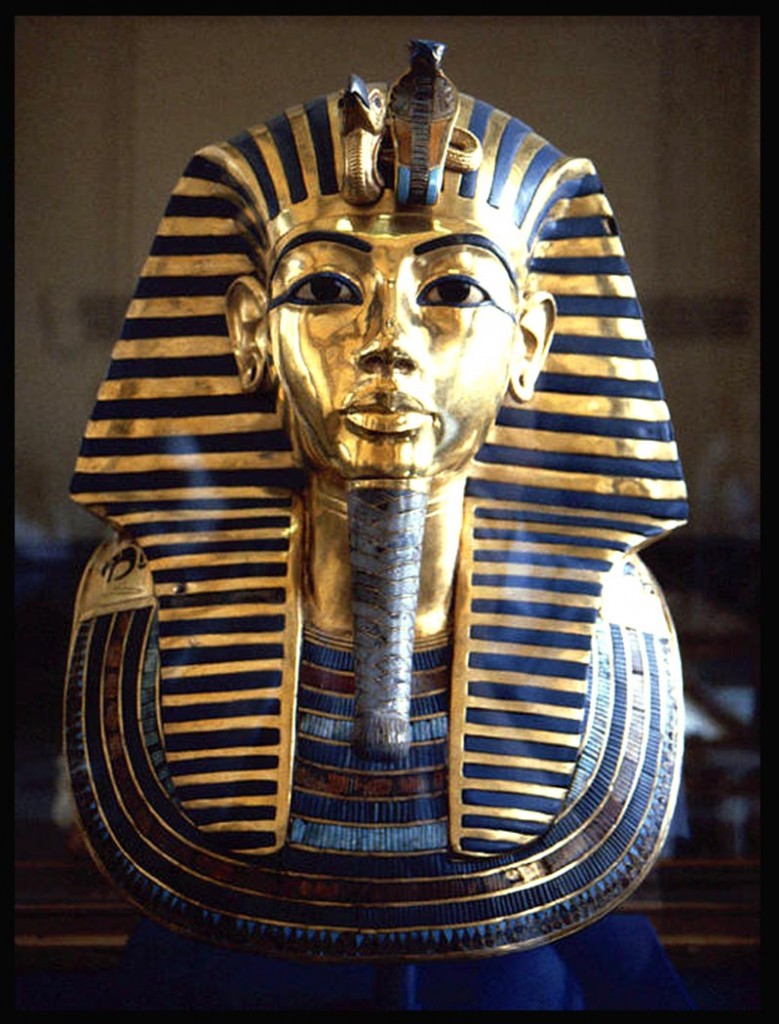
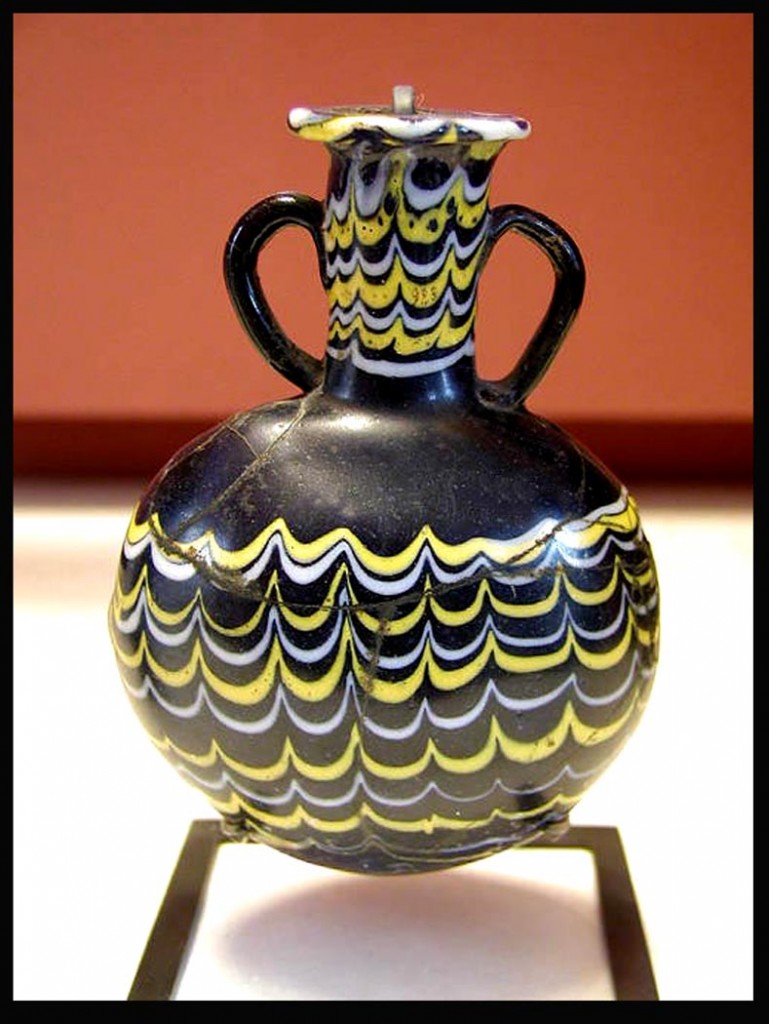
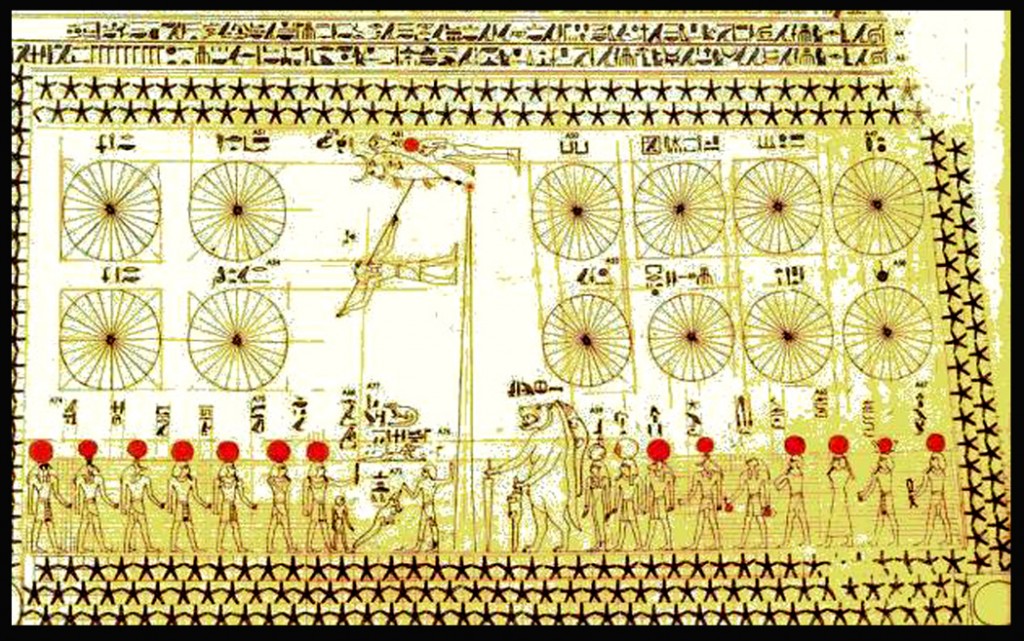
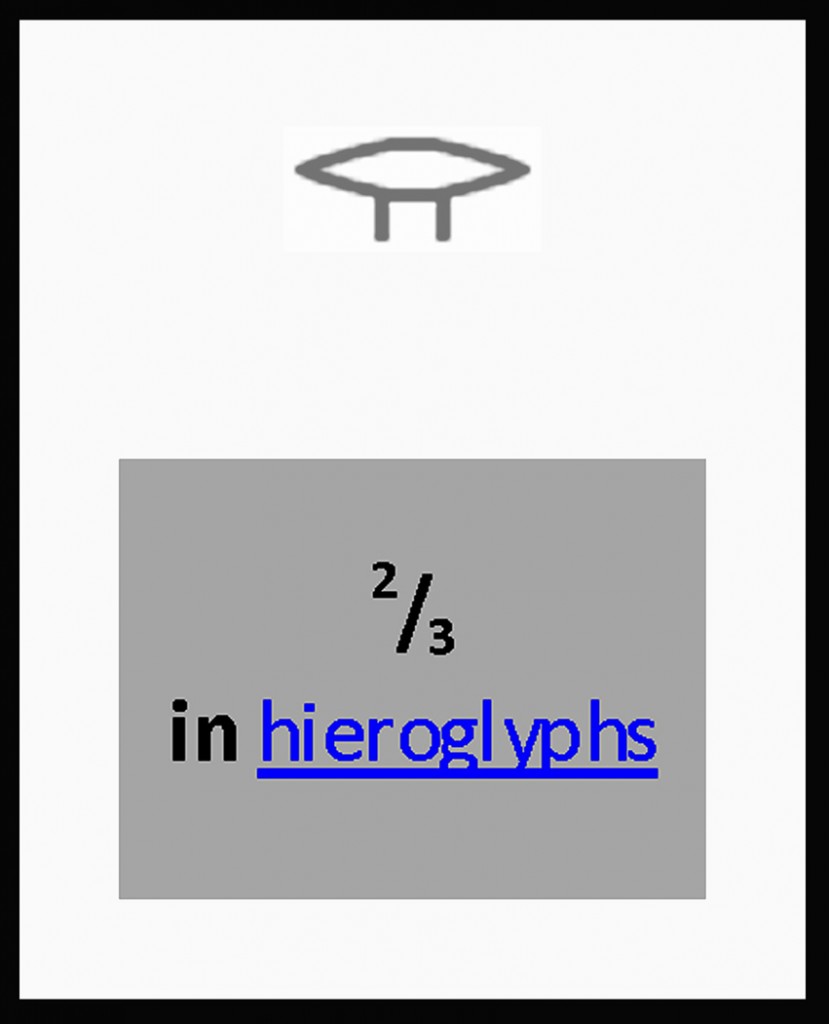

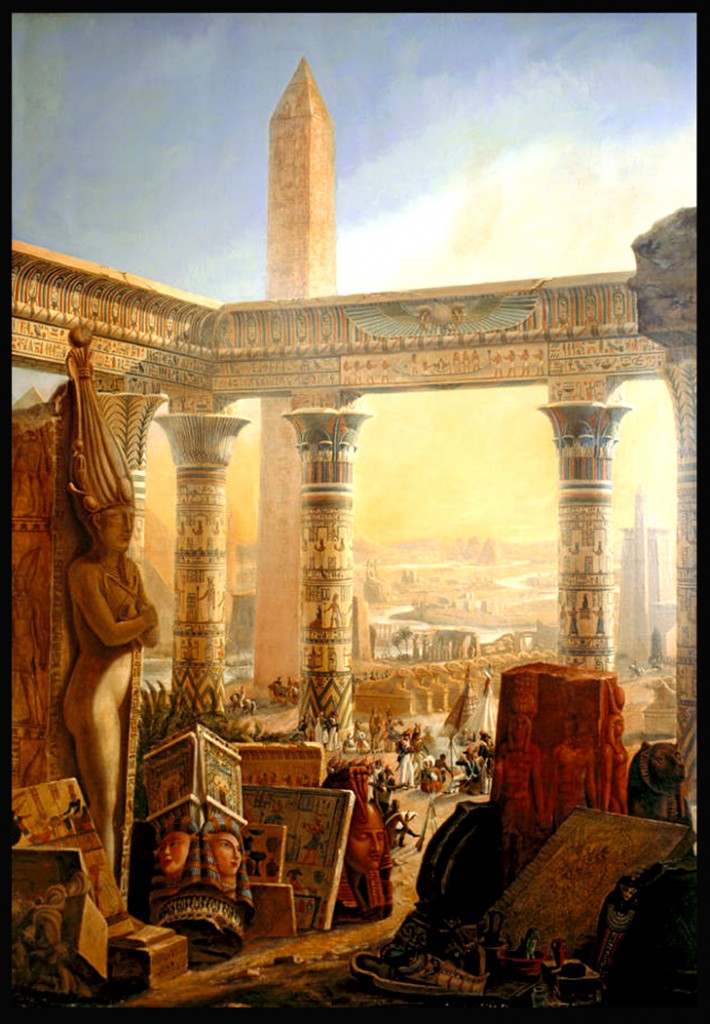
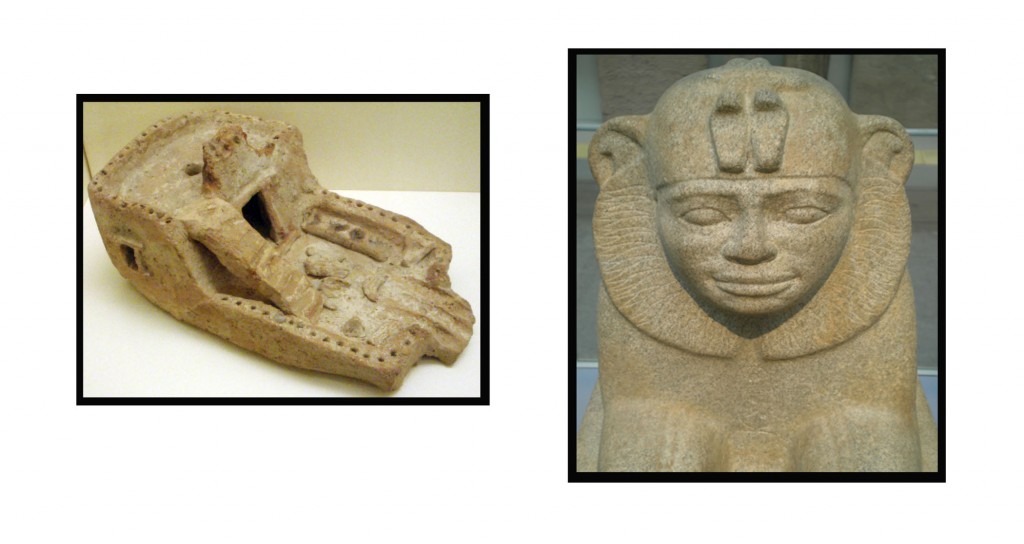
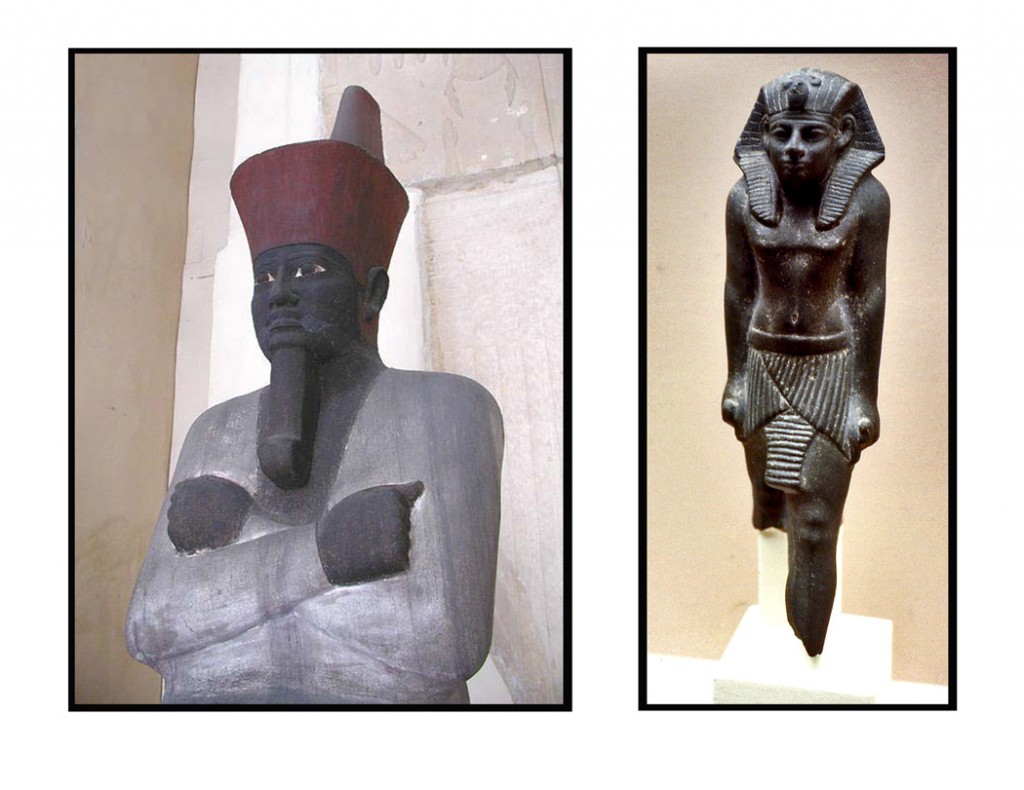
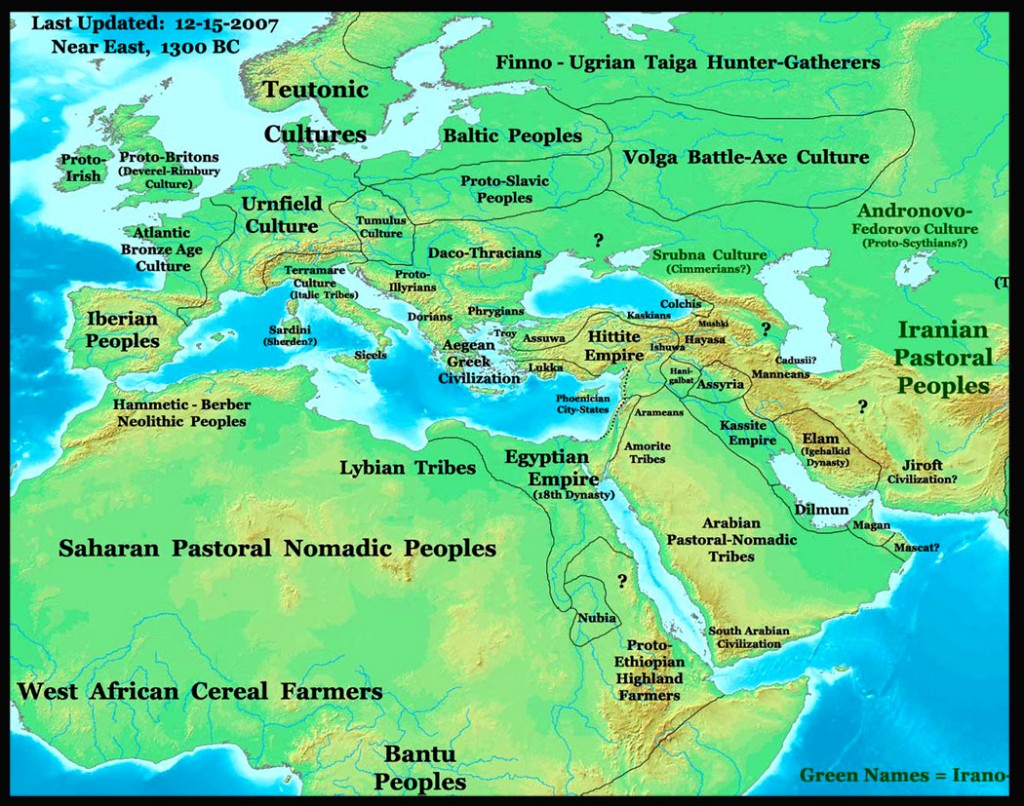
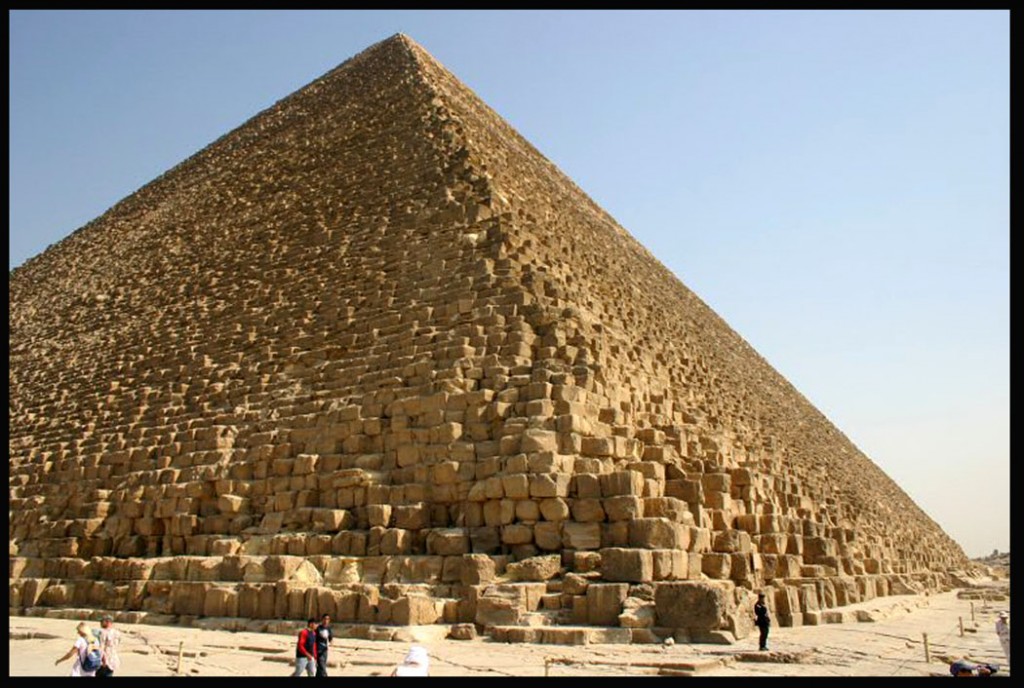
Leave a Reply